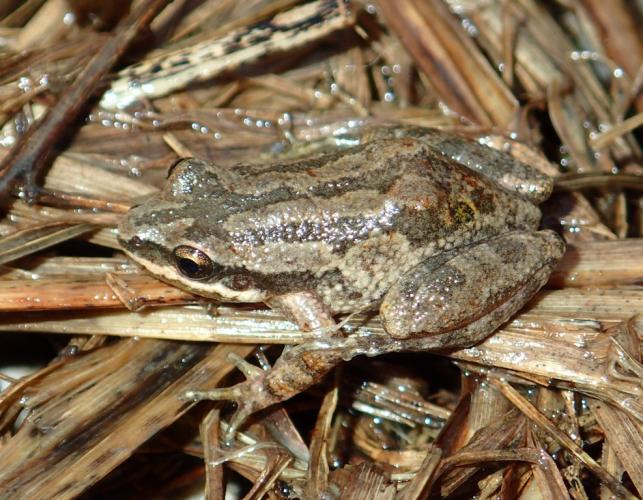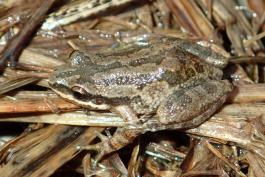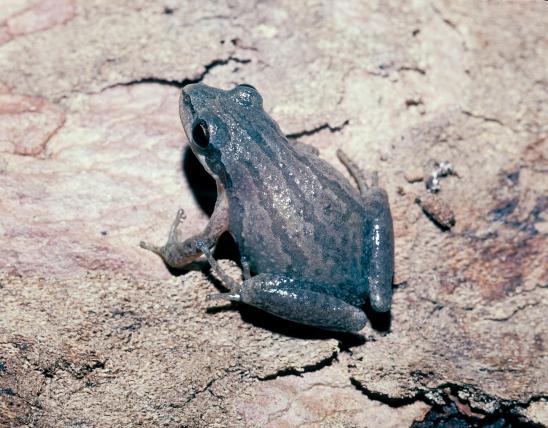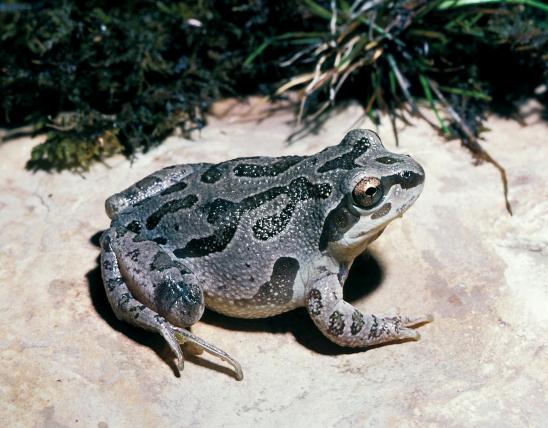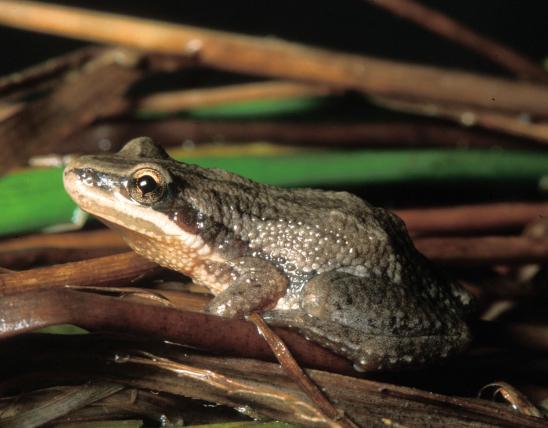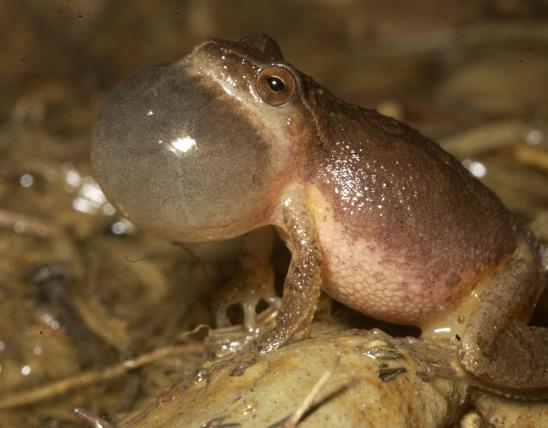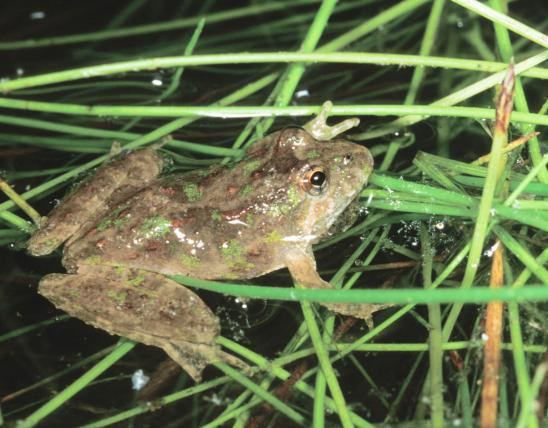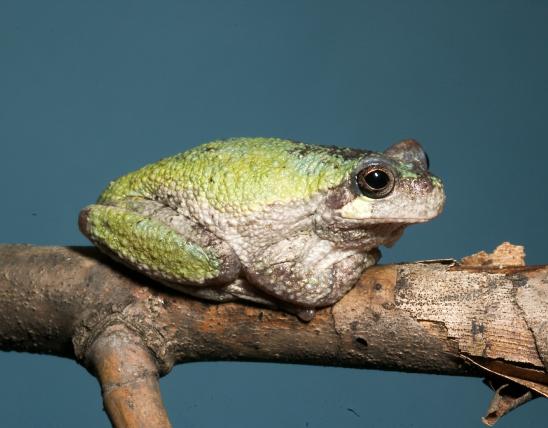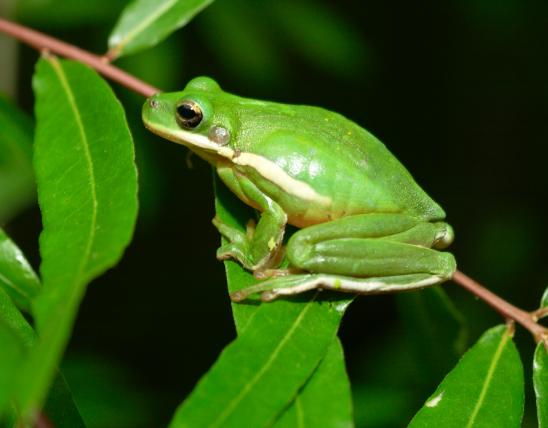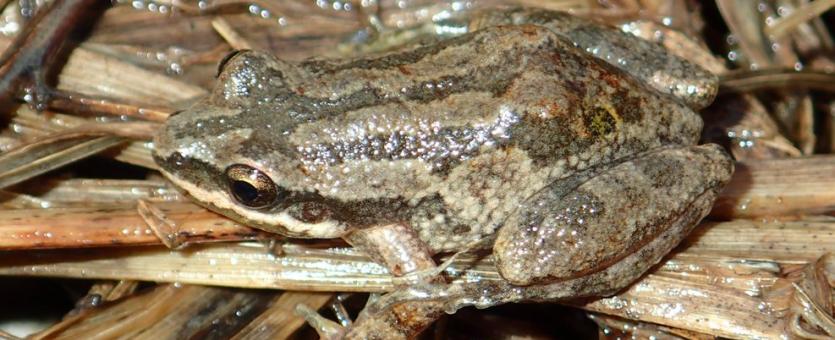
The Cajun chorus frog is a small tan to brown frog with dark dorsal stripes that are narrow or often broken into a series of dashes or spots. A gray, irregular stripe extends from the snout through the eye and down each side to the groin. A dark spot on the head between the eyes may be triangular. The belly is white or cream-colored. During the breeding season males have dark throats.
The call of the male Cajun chorus frog is a clicking trill of “crrreeeeeek” that sounds similar to running a finger along the tines of a pocket comb. They have a much slower call rate and slightly longer call than both the upland chorus frog (Pseudacris feriarum) and boreal chorus frog (Pseudacris maculata).
Similar species: In the hylid family, nine species, in three genera, are native to Missouri:
- Acris, the cricket frogs, one species: Blanchard’s cricket frog;
- Hyla, the treefrogs, three species: gray treefrog, Cope’s gray treefrog, and green treefrog; and
- Pseudacris, the chorus frogs, five species: spring peeper, upland chorus frog, Cajun chorus frog, Illinois chorus frog, and boreal chorus frog.
The Cajun chorus frog is similar in appearance and natural history to the upland chorus frog and the boreal chorus frog. The three can be distinguished by genetics, color patterns, slight differences in calls, and distribution.
The distribution of the upland chorus frog and the Cajun chorus frog in Missouri is somewhat uncertain. The upland chorus frog appears to occur mostly within the Mississippi Lowlands of extreme southeastern Missouri, but its range seems to overlap with that of the Cajun chorus frog as one moves west, and it may also overlap with the boreal chorus frog as one moves north in Missouri.
It is possible that previous records of frogs identified as upland chorus frogs from the southeastern Ozark Highlands are actually Cajun chorus frogs. It is also possible that upland chorus frogs are only found in the Mississippi Lowlands of extreme southeastern Missouri. Additional genetic studies are needed to better understand the boundaries of these three species, especially in potential areas of overlap.
Adult length (snout to vent): ¾ to 1 inch; occasionally to about 1¼ inches. Females are larger than males.
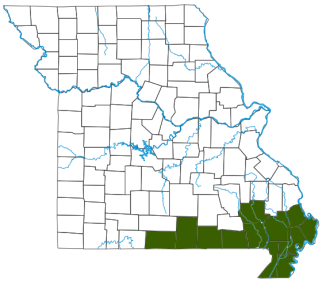
This newly described species of chorus frog currently is known from a few counties in southeastern Missouri: Ripley, Butler, and Stoddard. It probably also occurs in the three Bootheel counties (New Madrid, Pemiscot, and Dunklin) and westward along the Arkansas border to about Ozark County.
Habitat and Conservation
Little is known about the basic life history of this newly described species in Missouri. The Cajun chorus frog primarily lives in a variety of habitats from forested areas to open grasslands and fields. This frog appears to be most common in bottomland forests, small patches of woods, and along the edges of swamps and marshes. Although commonly heard calling from breeding wetlands, Cajun chorus frogs are rarely seen outside of the breeding season.
Food
Like its close relatives, the Cajun chorus frog forages in moist leaf litter and feeds on a variety of small invertebrates, especially insects.
Status
The Cajun chorus frog is a newly described species. Genetic data and differences in calls showed that this species was different from other trilling chorus frogs that once occurred in multiple states. It is likely that the Cajun chorus frog occurs in more locations in southeastern Missouri, but additional genetic data and calling surveys are needed to better understand the distribution of this new species.
Life Cycle
The reproductive biology of the Cajun chorus frog has not been studied extensively in Missouri. Cajun chorus frogs breed in late winter or early spring. They have been heard calling in southeastern Missouri from February to early April, with peak activity in March.
The Cajun chorus frog breeds in shallow, well-vegetated, temporary bodies of water, such as roadside ditches, flooded fields, water-filled depressions, swamps, and marshes, that are located within or near wooded areas. Breeding occurs in shallow water. A female may lay up to 1,500 eggs, in several loose, jelly clusters that are attached to twigs, sticks, and grasses. Each egg cluster may contain 7–176 eggs, averaging about 43 eggs, and a female may lay up to 9 clusters of eggs within a single night. Hatching occurs in about 4–11 days. The tadpoles generally live in the water for 48–80 days, depending on water temperature. The young froglets usually remain within about 32 feet of the wetlands for several weeks.
Human Connections
These frogs help control populations of sometimes-troublesome insects; also, because they are sensitive to pollutants, they are an indicator species, whose health and population numbers help us to gauge the health of their ecosystem.
Chorus frogs and spring peepers are some of the earliest signs of spring in Missouri. After a long winter, it's wonderful to step outdoors at night and hear their welcome calls echoing from the woods and lowlands.
The species name, fouquettei, honors the herpetologist Martin J. “Jack” Fouquette, Jr. (1930–2014), who taught at Arizona State University from the 1960s until 2005. Among his many research interests were bioacoustics, including the calls of chorus frogs. During the 1950s when his career began, tape recordings and sonograms were a rather new technology that allowed researchers to gather and analyze frog calls.
The name "Cajun" refers to this frog's overall distribution, centered on Louisiana, western Mississippi, Arkansas, and eastern Oklahoma and Texas. The frog's range is reminiscent of the historically French-settled territory of Lower Louisiana, which centered on New Orleans and the surrounding "Cajun country."
Ecosystem Connections
These small frogs prey on numerous insects and spiders, helping to control their populations, but they also fall prey to many larger predators at each stage of their life cycle.
Cajun chorus frogs breed in ephemeral, fishless wetlands. These shallow little ponds, ditches, flooded fields, and such may seem insignificant to people, but they are critical breeding habitat for these and many other amphibians.
